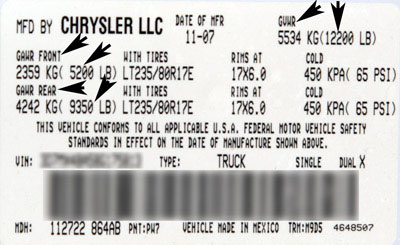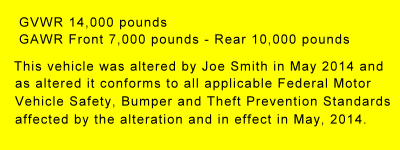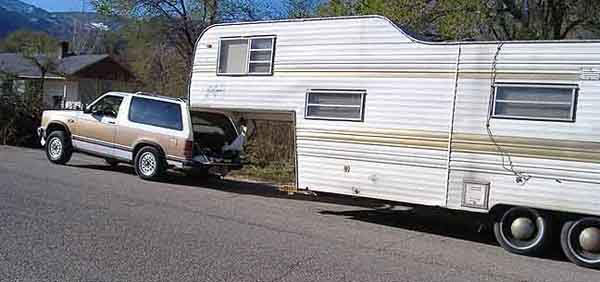

On any RV forum you'll read statements such as "you cannot change the manufactures tow rating or carrying capacity" or "you may be able to change the capabilities of the truck, if you address all weak links in the chain, but you cannot change the manufacturer's rating."
The big question is, is there any part of this assertion true?
One RV related forum had a brief and incomplete discussion referring to 49 CFR 567.7 - Requirements for Person Who Alter Certified Vehicles. For the layman reader, it could be interpreted as an avenue for an owner to modify the Certification Label. In order to obtain the legally correct answer, it required contacting a representative at NHTSA.
I had a very informative conversation with John at NHTSA. John confirmed that 49 CFR 567.7 DOES NOT apply to the consumer or individual vehicle owner. The law basically applies only to the manufacturer or an authorized vehicle "alterer."
The Legal definition: "Alterer means a person who alters by addition, substitution, or removal of components (other than readily attachable components) a certified vehicle before the first purchase of the vehicle other than for resale."
An "Alterer" approved by NHTSA may modify vehicles following very strict guidelines. Upon completion of a vehicle alteration, an additional label must be applied near and not covering the Original Equipment Manufacturer's (OEM) Certification Label. The additional label may appear similar to the following example:

When reading any type of vehicle related forum, it's obvious that thousands of owners modify their vehicles to improve the load capacities or performance with manufacturer certified components. Owners commonly add aftermarket products such as air lift systems, helper springs, and higher capacity wheels and/or tires, as well as improving the rear end gear ratio or upgrading the transmission, etcetera. Any or all these modifications may improve the vehicle towing or load capacity, or performance.
John and I discussed the fact that vehicle owners do modify vehicles and he stated there is no prohibition to do so. But he did emphasize that those changes will not change the OEM Certification Label ratings. He also noted that there is no prevision for NHTSA to enforce compliance on consumers as well. He went on to say that consumers automatically assume legal responsibility for all modifications made to a vehicle and they must endure the risk. John also shared that one of the strongest safety concerns that NHTSA has for owners is failure to actually improve the weakest link in vehicle load requirements which could result in dangerous driving condition.
One of the most important keys for anyone who alterers a vehicle is they must assume legal responsibility for all duties and liabilities. But in reality, does not any driver behind the steering wheel assume legal responsibility while diving on the highway regardless of any modifications? There are laws covering all types of driving situations. To this author's knowledge, no state has a law prohibiting private owners from driving a vehicle that's overloaded either. There are a few states that will issue a ticket if it is discovered the vehicle was hauling more than the declared weight registration. That does not necessarily mean the vehicle was overloaded per the OEM Certification Label. The consensus among law enforcement officers appears to be that if a vehicle or towing combination appears to be safe, they will not pull you over. Vehicle weight enforcement applies primarily to commercial drivers. If a towing combination appears similar to the following photo, there is a pretty good chance of being pulled over for unsafe driving conditions.

Whatever vehicle modification you install, travel safely on the highway using certified manufacturer's components and assume responsibility.
Copyright © 2014, Dave Gray, Reprint by permission only.
Here is a similar response to an individual's inquiry found at RamForumZ.com
Q: What about axle air springs (bags) like the Firestone Ride-Rite - Want they increase my load capacity?
A: No. Here is a direct quote from Firestone/Ride-Rite FAQ page: "Absolutely not. Only the vehicle manufacturer can set the GVWR. Even with the air springs, you have the same brakes, axles, bearings, and frame stiffness, which in part determines the vehicle’s load capability. The Ride-Rite™ air springs simply allow you to carry the maximum capacity of your truck more comfortably and without suspension sag and the poor handling that comes with it."
©2011-2025 Fifth Wheel Street and Fifth Wheel St. All Rights Reserved. Use of this website constitutes acceptance of the Privacy Statement and Terms and Conditions of Use.